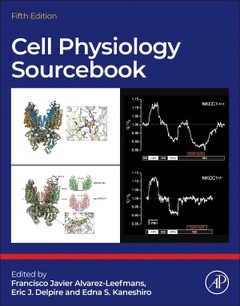Cell Physiology Source Book (5th Ed.)
Coordonnateurs : Alvarez-Leefmans F. Javier, Delpire Eric, Kaneshiro Edna

Cell Physiology Source Book, Fifth Edition covers a broad range of topics in cell physiology. The book discusses research areas that have become active since the last edition (e.g., aquaporins, apicoplast and other organelles) and broadens its scope to include chronobiology, expansion of receptor/sensory physiology, endocrinology, and other topics such as quorum sensing and taxis. As methods or approaches on performing experiments appear to be very valuable parts of books to which readers tend to frequently refer, expansion of these types of chapters and/or appendices are included in this edition.
Applicable to scientists, researchers, postdocs and graduate students across physiological, biochemical, biological and biomedical backgrounds, cell physiology is important for understanding larger organisms and potential advances in biomedicine.
SECTION I. Biophysical Chemistry, Cell Structure and Function 1. Water, Solutions, and Colligative Properties, Simple Diffusion, Permeability 2. Lipids Artificial Membranes, Ionophores, Lipid Rafts, Liposomes 3. Nucleic Acids Nucleus, Nucleolus, DNA, Chromosomes, Mitotic Spindle, Plasmids, Organellar DNA, Telomeres, DNA and RNA Editing, also see chapter 8) 4. Proteins Cytoskeleton, Enzymes, Carriers, Protein Folding, Protein Crystallography 5. Carbohydrates Glycocalyx, VSG, Mucins (e.g., T. cruzi), Receptors (Immune System, Lectins) 6. Cell Membranes Bilayer Model, Lateral Mobility (Fluorescence Recovery After Photobleaching) 7. Prokayotic Cells (eubacteria, archaea) 8. Protists kDNA, Self-splicing, telomeres, apicoplasts, hydrogenosomes, mitosomes 9. Organelles
SECTION II. Membrane Potentials, Transmembrane Translocation 10. Membrane Potentials and Membrane Transport Gibbs-Donnan Equilibrium, Ion Channels in Non-Excitable Membranes, (Mutations, Disease, Toxin- & Drug-Binding) 11. Carrier-Mediated Transport/Facilitated Diffusion Overview Ions (Na+, K+, Cl-), Sugars, Amino Acids, Nutrients, Drugs 12. Na+/K+ ATPases 13. Ca2+ Transport and Signaling (Surface Membrane, Cytosolic, Nuclear) 14. Proton-Motive Force Ion Gradients, Chemosmotic Energy Transduction, Bacterial Flagella, Mitochondrial/Chloroplast Membrane Potential and Energy Production.
SECTION III. Membrane Excitability, Regulation of Ion Channels 15. Cable Properties, Length Constant, Electrogenesis of Membrane Excitability, Propagation of Action Potentials, Inhibition 16. Voltage and Current Clamp (e.g., Oocytes, BLM), Patch-Clamp, Single Channel Techniques 17. Voltage-Gated Channels 18. Regulation of Mechanosensitive Channels, GTP, Cyclic nucleotides, G-proteins 19. Nuclear Envelope
SECTION IV. Integration, Synaptic Transmission, Sensory Transduction 20. Ligand-Gated Ion Channels 21. Synaptic Transmission, Gap and Tight Junctions 22. Excitation-Secretion Coupling, Trophic Effects of Nerves on Muscles? (see Endocrine?) 23. Photoreceptors: Vision, Eye spots, Ocelli, Compound Eyes, Color Vision 24. Mechanoreceptors: Sound, Balance, Stretch Receptors Pacinian Corpuscle, Hearing 25. Pressure Receptors: Posture, Acceleration, Fish Lateral Line 26. Chemoreceptors: Smell, Taste 27. Electroreceptors, Magnetoreceptors (Magnetosomes), Thermoreceptors 28. Brain, Glia.
SECTION V. Contractile Systems, Cell Locomotion, Muscle 28. Microtubule + Dynein + ATPase, Eukaryote Cilia 39. Proton-Motive Force, Bacterial Flagella 31. Spasmin/centrin + Ca2+, Rubber? 32. Actin +Myosin + ATPase, Amoeboid Movements, Lymphocytes 33. Skeletal Muscle, Excitation-Contraction Coupling, Sarcoplasmic Reticulum, Mechano-Chemistry, Insect click flight muscle? 34. Smooth Muscle 35. Cardiac Muscle
SECTION VI. Integration, Endocrine, Exocrine Systems, Chemical Messengers, Hormones 36. Pituitary/Hypothalamus 37. Adrenals 38. Reproductive Physiology 39. Respiration, Gas Transport, Respiratory Pigments, Acid-Base Balance 40. Osmoregulation, Volume Regulation, Aquaporin, Ice/Freezing, Counter- Current Systems, Counter-Current Multiplier (Active Transport) Systems
SECTION VII. SPECIALIZDED PROCESSES 41. Bioluminescence 42. Plant Cell Physiology, Plastids, Photosynthesis, Stomata Opening 43. Cell Migration, Quorum Sensing, Taxis, Kinesis, Tropism 44. Biological Clocks/Chronobiology, Diapause, Hibernation, Brown Fat
SECTION VIII. Experimental Methods/Approaches Cell Biology – Microscopy, GFP, Specific Stains, In Situ Hybridization, Light, Phase-Contrast; Fluorescence Microscopy, Fluorescence Resonance Energy Transfer (FRET); Multi-Photon, Electron Microscopy, Confocal, Imaging, FISH, Atomic Force, STORM/Single Molecule Imaging, Photoactivated Localization Microscopy (PALM); Total Internal Reflection Microscopy (TIRF), Fluorescence Recovery After Photobleaching Molecular Biology –Nucleotide Sequencing, Whole Genome Analysis, Mutagenesis, Recombinant DNA, PCR, SDS-PAGE, Western Blots, Expression Systems, Antibody Preparation. Biochemistry - Enzyme Kinetics; Gas-Liquid Chromatography, Mass Spectrometary, Nuclear Magnetic Resonance Spectroscopy, Fourier Transforms, X-ray Scattering, Electron Spin Resonance Spectroscopy Biophysical – Optical Tweezers, Magnetic Resonance Imaging High Throughput – Bioinformatics, Genomics, Proteomics
- Contains a broad range of topics in cell physiology, thus providing a more complete picture of cellular functions
- Presents a single volume source that covers cell physiology in an easily accessible format
- Includes color illustrations throughout
Date de parution : 12-2023
Ouvrage de 1025 p.
21.5x27.6 cm
Disponible chez l'éditeur (délai d'approvisionnement : 14 jours).
Prix indicatif 187,99 €
Ajouter au panierThème de Cell Physiology Source Book :
Mots-clés :
Biophysics; contractility; enzymes; hormones; methods; microbes; organelles; osmoregulation; receptors; transport



